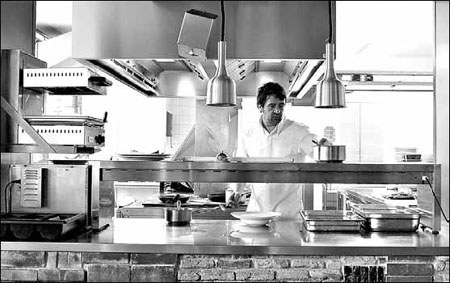Dutch food gets back a bit of zing
Updated: 2013-03-10 07:51
By David Segal(The New York Times)
|
|||||||
|
Frenk van Dinther is chef at Wilde Zwijnen in Amsterdam, one of a few restaurants listed by a critic as helping turn around a food wasteland. Herman Wouters for The New York Times |
AMSTERDAM - The Netherlands has never been known as a culinary destination.
Actually, that's an understatement, which is puzzling, given that the Dutch once dominated the world's spice trade. And nowhere is this puzzle more obvious than in Amsterdam, a city of beguiling streetscapes, gorgeous canals and really lousy restaurants.
What is a tourist in search of a good meal to do? In recent years, the answer has been to visit Dutchgrub, a blog written by Mark Schiefelbein, a 44-year-old native of Germany who moved here from France in 1999. "Amsterdam was a food wasteland at the time," he said.
There were a few Michelin stars spread around the city, but those spots were, and remain, pricey and formal.
Mr. Schiefelbein was looking for inventive meals at reasonable prices, places you could visit a few times a month without going broke. When he started Dutchgrub in 2007, Mr. Schiefelbein could get excited about only a handful of restaurants, and there was nowhere to find decent pizza or a burger whose patty wasn't just plucked from a freezer.
But the situation is improving, Mr. Schiefelbein said. His "Best Amsterdam Restaurants" list now has six entries. One is modern French (Marius), one traditional French (Madelief) and one is a mix of Mediterranean and Asian (Blauw aan de Wal), while the others are hybrids.
The latest addition is Wilde Zwijnen, which translates as Wild Boar and is as close to Dutch cuisine as anything on the list. A recent menu included fried catfish with ravigote, and croquettes of goat cheese, potato and hazelnut with carrot coleslaw, spinach and beetroot. There was also "Fish from Urk."
"I work with a guy who has one boat," said Frenk van Dinther, the chef at Wilde Zwijnen. "He basically tells me what I'm going to cook. Him and the vegetable man. They have more say over my menu than I do."
The interior design of the restaurant could be called austerity chic: a lot of exposed brick, simple furniture and a few hanging plants. Mr. van Dinther said that a lot of Dutch patrons, who have come to expect more frippery, find the look threadbare.
"Americans and Germans get this place," he said. "A lot of Dutch don't."
The problem may be that Wilde Zwijnen reminds the Dutch of the utilitarian ethos that has dominated its cuisine for decades. It wasn't always so, writes Karin Engelbrecht, a restaurant critic for Time Out Amsterdam. The Dutch, she explains, cooked with elan until the start of the 19th century, visible in still-life paintings of the era, which showed off tables piled high with delectables. Meals were lavish, multicourse affairs that started with leafy greens and ended with pastries and hippocras, a wine sweetened with cinnamon and served warm.
Then, as the Dutch started to lose their colonies and population growth started to strain resources, a new frugality took hold. But what really set Dutch kitchens on a path toward stodgy was the popularity, starting in the late 19th century, of huishoudschool. A type of domestic-science school, it taught girls to produce meals that favored nutrition and cheapness over flavor and pizazz.
"It became all about, what do you need to feed yourself and stay healthy?" Ms. Engelbrecht said. "Recipes weren't about using those lovely spices that we created the sea routes to India for. Those were nice to have, but you didn't need them to survive."
That keep-it-basic approach endures.
Mr. Schiefelbein said he works with several Internet start-ups, "and when lunchtime comes, somebody goes around and collects a few coins and somebody heads to the supermarket around the corner and gets some slices of cheese and sliced bread. That's what people have for lunch."
Mr. Schiefelbein is not easy to please and has bumped some pretty fine restaurants off his recommended list. That includes De Kas, which is on the edge of a lush park east of the center of the city where the three-course $62 prix fixe menu recently included slow-cooked pork belly with a side of lentils and Granny Smith apples, and a confit of white onions. The guiding principle here is to keep it simple and focus on the ingredients. The results have won raves from diners and critics alike.
But Mr. Schiefelbein says the place has slipped recently. "De Kas has beautiful design, it has tablecloths, they have thought a lot about presentation. But the food isn't there."
The New York Times
(China Daily 03/10/2013 page12)
